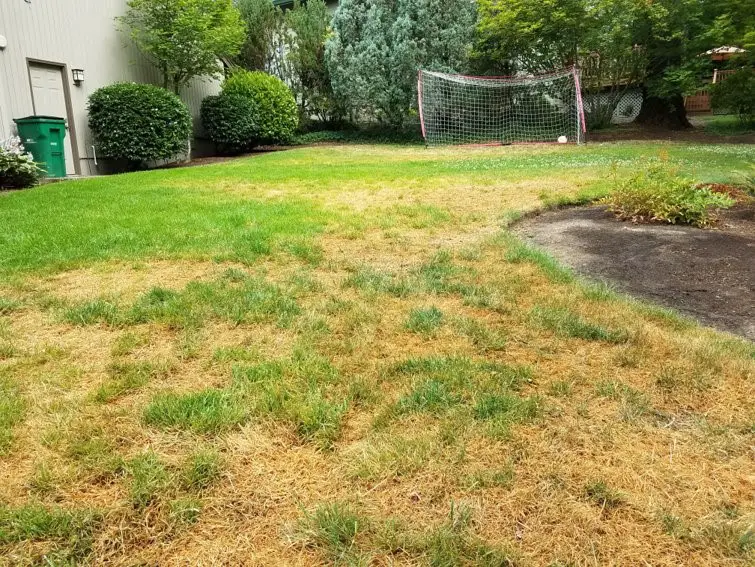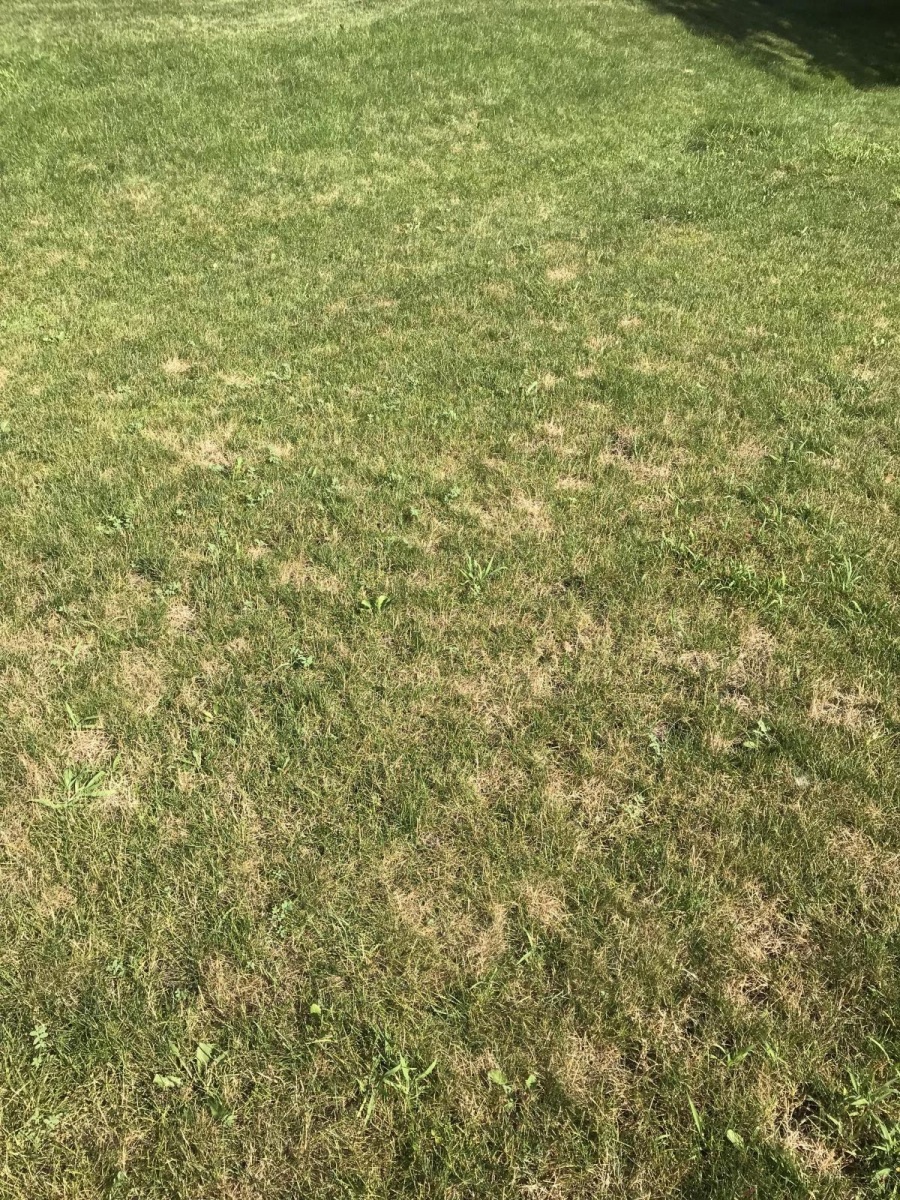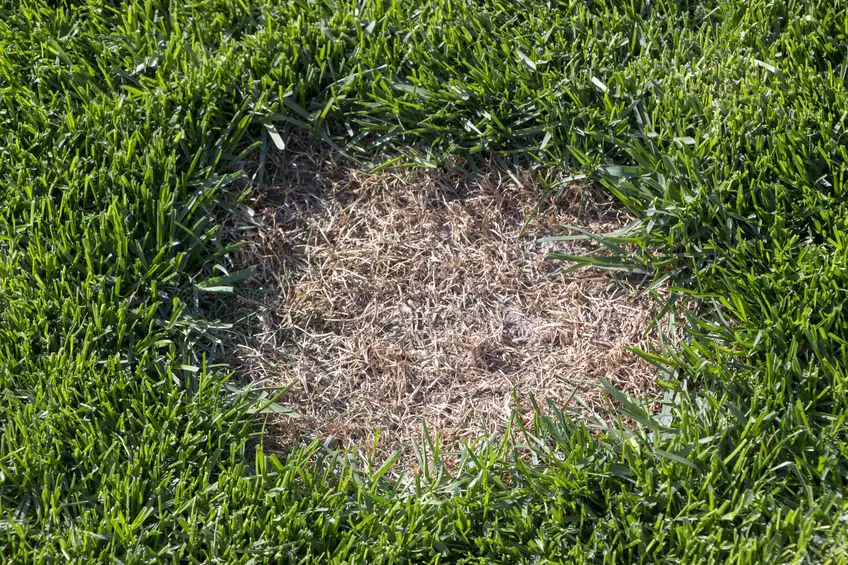How To Maintain Your Lawn To Help Reduce Brown Patch
A healthy lawn is a stronger lawn and will be better able to withstand fungal diseases like brown patch. Follow these guidelines:
- Plant disease-resistant varieties and seed mixtures. For example, Scotts® Turf Builder® Grass Seed Heat-Tolerant Blue® Mix for Tall Fescue Lawns combines improved turf-type tall fescue varieties with a heat-tolerant Kentucky bluegrass to help reduce the impact of brown patch on your lawn.
- Reduce the amount of time the grass blades are wet. When needed, water during the early morning hours. Dont water between 7:00 PM and 3:00 AM, as the blades will stay wet overnight.
- Feed the lawn regularly with Scotts® Turf Builder® Lawn Food. Be sure to follow label directions, as overfed lawns are more susceptible to brown patch.
- Unless it is a controlled-release product, dont apply nitrogen fertilizer when hot, humid weather is expected .
Since wet conditions help promote brown patch, make sure your lawn has good drainage and air flow, and consider pruning overgrown trees to prevent too much shade and increase air movement for faster drying. It may also be helpful to aerate and dethatch the lawn every 1 to 3 years to allow air, water, and nutrients to move more freely into the soil.
Why Is My Lawn Brown Some Symptoms To Look For
Getting to the bottom of your lawn problems all starts with a little bit of sleuthing. The truth is, dead spots in the lawn can be caused by quite a few different culprits and determining which one is at fault isnt exactly easy.
It can help to look for specific symptoms to clue you into what might be causing the brown or dead spots on your lawn. Here are some things that you might notice as you dig deeper into your Pennsylvania lawn problem. Well get into more detail about the causes of these symptoms later in this article.
- Distinct patterns
- Grass changing color from green to yellowish or brown
- An influx of animals like moles, skunks, and birds visiting your yard
- Lawn that is peeling up or can be rolled like a carpet
- Grass that gets matted down when you walk on it
Dead Spots In The Lawn: Causes To Consider
If youre trying to figure out why is my lawn dying, then youll want to consider some of these common causes. Keep in mind that it may be one or more of these issues. Its quite common that a lawn can be suffering from multiple problems at the same time, making it even more challenging to get it under control.
Don’t Miss: How To Rid Lawn Of Clover
How To Repair Dog Holes And Other Lawn Damage
Dogs, especially puppies, have a lot of energy that they often devote to digging. They may dig for entertainment, to try and escape, or to hunt prey such as moles.3 It can take some time to train your dog to stop digging once they develop the habit, so intervene earlywith attention, training and praiseto stop digging problems right away.
Step in with quick lawn repairs to fix digging holes as soon as they appear:
For other lawn areas hit with doggy damage, turn to Pennington Lawn Booster. This all-in-one product combines premium Pennington Smart Seed, professional-grade fertilizer and soil enhancer. It’s guaranteed to grow quicker, thicker, greener grass in just one application.
Pennington, One Step Complete and Smart Seed are registered trademarks of Pennington Seed, Inc.
Another Cause Of Brown Grass: Dont Use A Dull Mower Blade

Dull mower blades rip through the grass blades instead of slicing them cleanly, and that stresses the plant. You can always tell a lawn thats been mowed with a dull blade because it looks brown on the top. Get on your hands and knees and you can actually see the damage. Be sure to sharpen your mower blade each season to keep your lawn in good shape.
Read Also: What Is The Best Cordless Lawn Edger
How To Control Armyworms
In large numbers, armyworm can advance like an army , strip the turf foliage and cause rapidly expanding bare patches.
Curl grubs are the larvae of beetles, like the African Black Beetle. Sometimes they are incorrectly referred to as witchetty grubs, they are C-shaped creamy coloured grubs that live in the soil and eat through the roots of your prized lawn.
In addition to bare patches, if you see birds pecking at the lawn, it can be a sign that lawn armyworm and curl grubs are present .
Yates Baythroid Advanced Insect Killer for lawns will help control common lawn pests like armyworm. Its a concentrated formulation, just follow the directions on the package for correct dilution rates.
How To Get Rid Of Dog Spots
Soak the patch until the grass is sopping wet to dilute the urine acids and salts and wash them deeper into the soil, beyond the grass roots.
Scrape up the dead grass with a hand rake and remove it. Rough up the area to loosen the soil 1/2-in. deep. Seeds germinate better in soft soil.
Sprinkle on a 1/2-in.-thick layer of topsoil, then pepper it with grass seed. Cover with a pinch of new soil and press it to firm it up. Keep the area moist until the new grass is about three inches high.
Recommended Reading: How To Deter Rabbits From Lawn
Why Does Your Lawn Have Brown Patches
There are a variety of reasons your lawn may develop Brown patch, including high heat and humidity, excessive nitrogen, moisture, poor soil damage, too much thatch , and compacted soil . In some cases, you cant prevent your lawn from developing Brown thatch-after all, you cant control the weather.
Which Fungicides To Pick
Clemsons HGIC guide also provides a table of fungicide active ingredients and their effectiveness on brown patch fungus:
Some that the table lists as excellent are:
- Pyraclostrobin in Pillar G Intrinsic Fungicide.
- Fluoxastrobin in Disarm 0.25.
- Azoxystrobin, both with and without Propicanazol.
Its a good idea to go ahead and pick up two different fungicides. Alternating which ones you use can help prevent a buildup of resistance to any certain fungicide.
Don’t Miss: What Is Pre Emergent Lawn Care
Brown Patch Loves Hot Summer
Brown Patch is the most damaging turf grass disease
Brown patch is really a summer lawn disease thats caused by a fungus called Rhizoctonia. The disease begins to show growth when temperatures reach 65°, but the most active growth of brown patch lawn disease occurs at temperatures of 80-85° when humidity levels are very high.
The fungi survive the winter in plant debris and enter the leaf tissue through wounds caused by mowing and through the pores when daytime temperatures get into the 70s. Infected turf grass can go quite a while without showing damage because its actively growing. But, if the daytime temperatures reach the mid 80s and nighttime air temperatures stay above 70°, the grass will be under stress. Then, lawn disease damage can become visible almost immediately.
What Type Of Grass Is Most Susceptible To Brown Patch
Brown Patch lawn disease is a common and widespread problem caused by Rhizoctonia solani fungus. The disease can infect a variety of common turfgrasses, but the most susceptible grass species include perennial ryegrass, tall fescue and the bentgrasses.
Brown Patch can also become a problem to Kentucky bluegrasses in mid-to-late summer during extended periods of high temperature and humidity.
Don’t Miss: How Much Should I Pay My Lawn Care Employees
How To Identify Brown Patch
If your lawn has begun to yellow rapidly, take a closer look at the size and shape of the affected areas. With brown patch, they are likely to be roughly circular, though a bit irregular. Patch sizes can range from a few inches to several feet in diameter. If brown patch has been active for a while, the spots might also look like patches of good grass with rings of dead or thin grass around them.
Besides yellow, do you notice any other colors in the patchy areas? Brown patch patches can be darker purple or burgundy on the outside, for example. Other signs include irregular tan spots bordered by a darker outline on grass blades, brown and shriveled blades, rotting at the base of the blades, darker blades that look water-soaked, and possibly white, cobweb-like growth around the blades .
Want Faster Results Using Fungicide Early May Be Your Key

Using fungicide early can be an effective way to control brown patch mold. There are many fungicides to chose from, and the one you chose will be largely dependent on what is available in your area, as well as the type of application that works best for you. Whichever fungicide you decide on, follow the instructions on the packaging. Most fungicides will need to be applied once or twice a month. For the best results, be certain to begin use fungicide at the first signs of brown patch fungus.
You May Like: Does Lowes Rent Riding Lawn Mowers
What Is Brown Patch Lawn Disease
Brown Patch lawn disease is a common and widespread fungus that, like Dollar Spot, can infect a variety of common turfgrasses and cause brown patches on your lawn. Brown Patch thrives when hot weather and high humidity settle in during the summer months. Uncommon in arid regions such as Southern California and the Mountain States, Brown Patch is a problem for yard-lovers in every other part of the U.S.
Seeing brown patches on your lawn? If you live in a region with hot temperatures and high humidity, you may find your lawn has been infected with Brown Patch lawn disease.
Read below for answers to frequently asked questions regarding the lawn intruder and tips to get your lawn healthy again.
How To Identify The Cause Of Brown Spots In Your Lawn
Brown spots in lawns are frustrating to deal with! Just when you think youve done everything right, suddenly theres a patch of grass thats dead or dying. There are a number of causes of brown spots in lawns, from insects to disease to human error.
To get to the bottom of the situation, youll have to do a little old-fashioned investigating. Heres a checklist to help you determine the cause of brown spots in your yard.
Don’t Miss: Kill Wild Violets In Lawn
Brown Patch Spreads Outward Quite Fast From A Central Point So As Soon As You Start To See Brown Circular Patches Popping Up In Your Grass Its Time To Get To Work
Weve outlined all the basics, from identification to prevention and eradication, so you can keep your lawn free of brown spots. That white blouse, on the other hand? Yeah, we cant help you with that onethere just seems to be a law of attraction between white shirts and coffee spills that we just cant figure out.
Three Most Common Diseases Causing Brown Patches On Lawn
Most of the summer lawn diseases that attack tall fescue and Kentucky bluegrass common in Midwest lawns prefer warm/hot and humid weather. The best conditions for brown patch or Pythium disease growth are daytime temperatures between 80 and 95 degrees F, night-time temps around 65 to 70 degrees F, and high humidity. High summer temperatures combined with late afternoon showers every day in late May through July can be a recipe for disaster for lawns.
There are three types of fungal diseases that our RYAN Pros treat most often. Every tall fescue variety is susceptible to these three diseases brown patch, dollar spot and Pythium blight. Learn how to differentiate between them and what you can do to get rid of these lawn diseases in your yard.
1. What Is Brown Patch Disease?
Brown patch disease appears as circular patches in your lawn.
Brown patch is a common lawn disease found in all cool-season grasses in the U.S. caused by a fungus called Rhizoctonia solani. It appears as brownish-yellow, irregular circular patches that range from 6 inches to several feet in diameter. Brown patch begins to grow when temperatures reach 65 degrees F, but it grows fastest when temperatures reach 80 to 85 degrees F and there is high humidity.
The diseased leaves usually remain standing, and close examination shows tan, irregularly-shaped lesions on the leaves with a dark brown border.
2. What Is Pythium Blight Disease?
Pythium blight appears suddenly and can kill your lawn.
Also Check: Can You Hydroseed Over An Existing Lawn
When Should I Treat My Brown Patch On My Lawn
Preventatively, fungicides should be applied to turfgrass fescue in the late spring or early summer. Frequently brown patch becomes obvious around the first week of May in the Upstate. Warm season turfgrasses require fungicide treatments in the spring, but especially in the fall for best disease control.
How To Treat Brown Patch In Your Houston Area Lawn
You can prevent and treat brown patch with one fungicide. We now recommend Heritage G for both uses. Call us at 281-431-7441.
Do you have a brown circle in your lawn? In this video, Houston Grass Owner Michael Romine talks about how to prevent and treat brown patch in your St. Augustine grass lawn. Our fungicide recommendation has changed to Heritage G.
Read Also: Too Much Lime On Grass
Can My Lawn Grow Back After Brown Patch Pythium Blight Or Dollar Spot
The only way the grass can recover from dollar spot and brown patch damage is for the grass to grow enough that the damaged blades are pushed up and mowed off, revealing new and undamaged blades below. Tall fescue and Kentucky bluegrass grass types grow more slowly as temperatures rise so it would take weeks or months for the grass to recover. And, it may require fall seeding to get the lawn back into shape. Thats why preventing damage before disease development is so important.
The best products for preventing and controlling lawn fungus are very expensive. Understanding turf diseases, their control, and when and how to apply them is very important. To get help with your lawn and protect it from fungus, request an estimate for disease control from a professional lawn care service.
What Time Is It Time To Get A Watch Or At Least A Water Timer Don’t Water At The Wrong Time

Watering the lawn too late in the day will leave the lawn damp at night. This is especially problematic in the cooler months as this is precisely the conditions brown patch mold thrives in.
Instead water in the early morning, preferably at sunrise. This will give the grass blades time to dry before nightfall.
Read Also: Spike Aerator Lowes
How To Spot The Fungus
The funny thing about brown patch is that it doesnt start out brown at all. In fact, the first signs of trouble are when a circular or oblong pattern of light-yellow discoloration appears in your grass. Eventually, the affected area will turn from orange to tan. It will continue to spread outward, sometimes leaving small green patches at the center. The discoloration is caused when the fungus infects each leaf, causing them to rot.
Brown patch fungus can affect all cool-season grasses, but it is especially harmful to ryegrass and tall fescue. Brown patch also affects a variety of warm-season grasses, including St. Augustine grass, Bermuda, and zoysiagrass.
One of the most frustrating aspects of brown patch is that once you spot it, the damage is already done and the fungus is thriving. The trick to successfully eradicating brown patch is understanding the fungus lives beyond where the eye can see, in your soil. When the conditions are right, the fungus strikes, making preventive measures all the more important.
How To To Get Rid Of Brown Patch Fungus On Grass
Many conditions can cause patches of brown, dead grass on your lawn, but only one gets the official name brown patch. Brown patch disease is a condition caused by a single species of fungus, Rhizoctonia, that often occurs in mid- to late-summer when the weather is hot and humid.
You May Like: Revive Lawn Lowes
Keep It Under Control
The good news is that your turf can recover from brown patch. The bad news? You may have to wait until the active growing season to see an improvement in appearance. While a fungicide application can help prevent spread to other areas, spots that have rotted will need to regrow.
Meanwhile, steps should be taken to ensure youre not transferring the fungus to healthy parts of your lawn. Affected areas should not be mowed, as that could cause diseased clippings to deposit elsewhere, spreading the infection. You should also avoid walking over the area so your shoes dont transport the spores. Finally, its important to not apply fertilizer during an outbreak. Sure, youll feed your lawn, but youll also feed the fungus, too.
Because brown or yellow spots can be the result of a number of causes, its important to have your lawn assessed by an experienced landscape professional. If brown patch is confirmed, proper treatment is critical. Self-diagnosis and treatment could make the problem worse. Our teams are experienced in treating brown patch, and can help make the process stress-free. Request a free quote or give us a call at .
